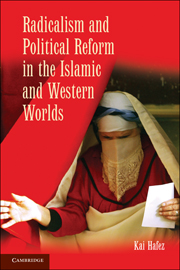Book contents
- Frontmatter
- Contents
- Introduction
- I MODERNITY
- 1 Conceptions of Modernity: Reform, Reformation and Radicalism
- 2 Political Cultures and Social Movements: The Social Rationality of Cultural Change
- II DEMOCRACY
- III POLITICAL VIOLENCE
- Conclusion: From ‘Holy War’ to Democracy? The Current State of Islamic and Western Modernity
- Bibliography
- Index
1 - Conceptions of Modernity: Reform, Reformation and Radicalism
Published online by Cambridge University Press: 05 June 2012
- Frontmatter
- Contents
- Introduction
- I MODERNITY
- 1 Conceptions of Modernity: Reform, Reformation and Radicalism
- 2 Political Cultures and Social Movements: The Social Rationality of Cultural Change
- II DEMOCRACY
- III POLITICAL VIOLENCE
- Conclusion: From ‘Holy War’ to Democracy? The Current State of Islamic and Western Modernity
- Bibliography
- Index
Summary
Western modernization theory has long been concerned with the question of why the West has attained a hegemonic position in politics, economy, and science over the last five hundred years, while other parts of the world have lagged behind. After the Second World War, a number of Western authors took the view that the key reasons for underdevelopment could be found in a tendency to cling to traditions and traditional values, not in specific political constellations or the injustice of the global economic order. For the Middle East, renowned theorists of modernization such as Daniel Lerner (1958) and Leonard Binder (1964) recommended the wholesale adoption of the Western developmental model. Modernization theory was applied in a wide variety of ways to political theories about the Middle East, such as neo-patrimonialism (Pawelka 1985; Springborg 1979) and neo-patriarchy (Sharabi 1988). These approaches shared a common orientation: they emphasized the weaknesses of modern state institutions when compared with the traditional loyalties of the tribe, village, and clientele, which seemingly undermine such institutions, covertly reinforcing stagnation.
Despite the justified criticism it has received, modernization theory was no classical colonialist hypothesis in scholarly garb. This key American notion was a marked improvement on the colonialist-racist doctrines that were widespread in Europe for many decades. Even as modernization theory insisted on the necessity of imitating the Western path, it nonetheless held out the prospect of such a process of learning and development in the non-European world.
- Type
- Chapter
- Information
- Publisher: Cambridge University PressPrint publication year: 2010



